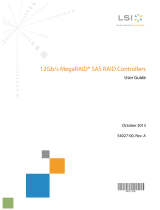
6
SAS protocol evolution
SAS-1
The speed of the first-generation SAS (SAS-1) link is 3.0 gigabits per second (Gb/s). The original SAS
standard defined two classes of expanders: edge expanders and fanout expanders. An edge
expander attaches directly to targets, or to another edge expander, which reduces its complexity (and
cost) by constraining the size of its routing table. Edge expanders can also be connected together to
form an edge expander device set, allowing the set to address up to 128 devices. A fanout expander
allows multiple edge expanders or edge expander sets to communicate with each other; therefore, it
has to maintain a more extensive routing table.
SAS-2
The second-generation SAS (SAS-2) link speed doubles the physical link rate to 6.0 Gb/s. SAS-2
eliminates the distinction between fanout and edge expanders by replacing them with self-configuring
expanders. SAS-2 also enables zoning for enhanced resource deployment flexibility, security, and
data traffic management. SAS-2 is backward compatible with SAS-1.
Each SAS device (initiator, target, or expander) may support one or more SAS communication
speeds. If any two linked devices support multiple speeds, the highest speed will be used if
performance is critical or a slower speed may be used if reliability is more important. During this
speed negotiation process, linked SAS devices determine their mutually supported SAS speed(s), and
other speed-related options, such as transmission amplitude, slew rate, de-emphasis, and spread
spectrum clocking.
After the speed negotiation process is complete, the SAS-2 standard provides a time interval, or
training window, during which the linked devices exchange predefined signals to test the link using
the selected speed(s) and speed-related options.
SAS-2.1
The enhancement to the SAS-2 standard, SAS-2.1, will define active cables, storage power
management, and additional connectors (see ―Cabling and connectors‖). Also, SAS-2.1 splits out the
protocol layer into a separate standard, SAS Protocol Layer (SPL).
Active cables
To help reduce cable weight, improve cable management, and improve airflow, the SAS 2.1
standard implements thinner cables with active circuitry. Active circuitry includes built-in drivers and
repeaters, along with an equalizer. The equalizer removes inter-symbol interference (ISI), a form of
signal distortion. The drivers and repeaters reduce the signal-to-noise ratio (SNR) by boosting the
received signal and by reducing near-end crosstalk (NEXT). NEXT occurs when two wires are close
enough for the signal traveling in one wire to interfere with the signal traveling in the other. Cable
designers reduced this phenomenon by placing a low-power equalizing filter inside the cable to
compensate for the dielectric and conductor losses. Economical, low-power, low-latency, active cables
enable high data transfer rates using thinner wire gauges over longer cable runs (Figure 3).


















